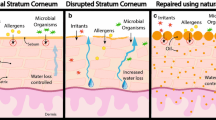Abstract
The metabolism of nitroglycerin (GTN) to 1,2- and 1,3-glyceryl dinitrate (GDN) by hairless mouse skin in vitro has been measured. In the first set of experiments, GTN was incubated with the 9000g supernatant of fresh, homogenized tissue in the presence and absence of glutathione (GSH), a cofactor for glutathione-S-transferase. After 2 hr of incubation with GSH, 30% of the initially present GTN had been converted to 1,2- and 1,3-GDN; without GSH, less than 5% of the GTN was metabolized. The ratio of 1,2-GDN to 1,3-GDN produced by the homogenate was 1.8– 2.1. In the second series of studies, GTN was administered topically to freshly excised, intact hairless mouse skin in conventional in vitro diffusion cells. The concurrent transport and metabolism of GTN was then monitored by sequential analysis of the receptor phase perfusing the dermal side of the tissue. Three topical formulations were used: a low concentration (1 mg/ml) aqueous solution, a 2% ointment, and a transder-mal delivery system. Delivery of total nitrates (GTN + 1,2-GDN + 1,3-GDN) into the receptor phase was similar for ointment and patch formulations and much greater than that from the solution. The percentage metabolites formed, however, was greatest for the solution (61% and 2 hr, compared to 49% for the patch and 35% for the ointment). As has been noted before, therefore, the relative level of skin metabolism is likely to be greatest when the transepidermal flux is small. Distinct from the homogenate experiments, the 1,2/1,3-GDN ratios in the penetration studies were in the range 0.7– 0.9. It would appear that homogenization of the skin permits GTN to be exposed to a different distribution of enzymes than that encountered during passive skin permeation.
Similar content being viewed by others
REFERENCES
P. K. Noonan and R. C. Wester. Cutaneous metabolism of xenobiotics. In R. L. Bronaugh and H. I. Maibach (eds.), Percutaneous Absorption, Dekker, New York, 1985, pp. 65–85.
D. A. W. Bucks. Skin structure and metabolism: Relevance to the design of cutaneous therapeutics. Pharm. Res. 1:148–153 (1984).
R. H. Guy, J. Hadgraft, and D. A. W. Bucks. Transdermal drug delivery and cutaneous metabolism. Xenobiotica 17:323–343 (1987).
R. J. Martin, S. P. Denyer, and J. Hadgraft. Skin metabolism of topically applied compounds. Int. J. Pharm. 39:23–32 (1987).
D. R. Bickers. The skin as a site of drug and chemical metabolism. In V. A. Drill and P. Lazar (eds.), Current Concepts in Cutaneous Toxicity, Academic Press, New York, 1980, pp. 95–125.
N. Higo, R. S. Hinz, D. T. W. Lau, L. Z. Benet, and R. H. Guy. Cutaneous metabolism of nitroglycerin in vitro. II. Effects of skin condition and penetration enhancement (accepted for publication) (1992).
R. C. Wester, P. K. Noonan, S. Smeach, and L. Kosobud. Pharmacokinetics and bioavailability of intravenous and topical nitroglycerin in the rhesus monkey. J. Pharm. Sci. 72:745–748 (1983).
G. C. Santus, N. Watari, R. S. Hinz, L. Z. Benet, and R. H. Guy. Cutaneous metabolism of transdermally delivered nitroglycerin in vitro. In B. Shroot and H. Schaefer (eds.), Skin Pharmacokinetics, Karger, Basel, 1987, pp. 240–244.
S. P. Denyer, W. B. Hugo, and M. O'Brien. Metabolism of glyceryl trinitrate by skin staphylococci. J. Pharm. Pharmacol. 36:61P (1984).
S. P. Denyer and C. McNabb. Microbial metabolism of topically applied drugs. In J. Hadgraft and R. H. Guy (eds.), Transdermal Drug Delivery, Dekker, New York, 1989, pp. 113–134.
E. Nakashima, P. K. Noonan, and L. Z. Benet. Transdermal bioavailability and first-pass skin metabolism: A preliminary evaluation with nitroglycerin. J. Pharmacokin. Biopharm. 15: 423–437 (1987).
F. W. Lee, N. Watari, J. Rigod, and L. Z. Benet. Simultaneous determination of nitroglycerin and its metabolites by capillary gas chromatography with electron-capture detection. J. Chromatogr. 426:259–266 (1981).
C. L. Gummer, R. S. Hinz, and H. I. Maibach. The skin cell: A design update. Int. J. Pharm. 40:101–104 (1987).
N. Bodor, J. Zupan, and S. Selk. Improved delivery through biological membranes VII: Dermal delivery of cromoglycic acid (cromolyn) via its prodrug. Int. J. Pharm. 7:63–75 (1982).
E. Boyland. The biological significance of metabolism of polycyclic compounds. Biochem. Soc. Symp. 5:40–54 (1960).
H. Marquardt, T. Kuroki, E. Humberman, J. K. Selkirk, C. Heidelberger, P. L. Grover, and P. Slims. Malignant transformation of cells derived from mouse prostate by epoxides and other derivatives of polycyclic hydrocarbons. Cancer Res. 32:716–720 (1972).
F. J. Di Carlo. Nitroglycerin revisited: chemistry, biochemistry, interactions. Drug Metab. Rev. 4:1–38 (1975).
S. H. Curry and S. M. Aburawi. Analysis, disposition and pharmacokinetics of nitroglycerin. Biopharm. Drug Dispos. 6:235–280 (1985).
P. Needleman and F. E. Hunter, Jr. The transformation of glyceryl trinitrite and other nitrites by glutathione-organic nitrate reductase. Mol. Pharmacol. 1:77–86 (1965).
P. A. Cossum and M. S. Roberts. Metabolite inhibition of nitroglycerin metabolism in sheep tissue homogenates. J. Pharm. Pharmacol. 37:807–809 (1985).
H. L. Fung, S. C. Sutton, and A. Kamiya. Blood vessel uptake and metabolism of organic nitrates in the rat. J. Pharmacol. Exp. Ther. 233:334–341 (1984).
P. K. Noonan and L. Z. Benet. Variable glyceryl dinitrate formation as a function of route of nitroglycerin administration. Clin. Pharmacol. Ther. 237:629–635 (1986).
M. Katz and B. J. Poulsen. Absorption of drugs through the skin. In B. B. Brodie and J. R. Gillette (eds.), Handbook of Experimental Pharmacology, Springer-Verlag, New York, 1971, pp. 103–173.
S. W. Collier, N. M. Sheikh, A. Sakr, J. L. Lichtin, R. F. Stewart, and R. L. Bronaugh. Maintenance of skin viability during in vitro percutaneous absorption/metabolism studies. Toxicol. Appl. Pharmacol. 99:522–533 (1989).
Author information
Authors and Affiliations
Rights and permissions
About this article
Cite this article
Higo, N., Hinz, R.S., Lau, D.T.W. et al. Cutaneous Metabolism of Nitroglycerin in Vitro. I. Homogenized Versus Intact Skin. Pharm Res 9, 187–190 (1992). https://doi.org/10.1023/A:1018925004345
Issue Date:
DOI: https://doi.org/10.1023/A:1018925004345




